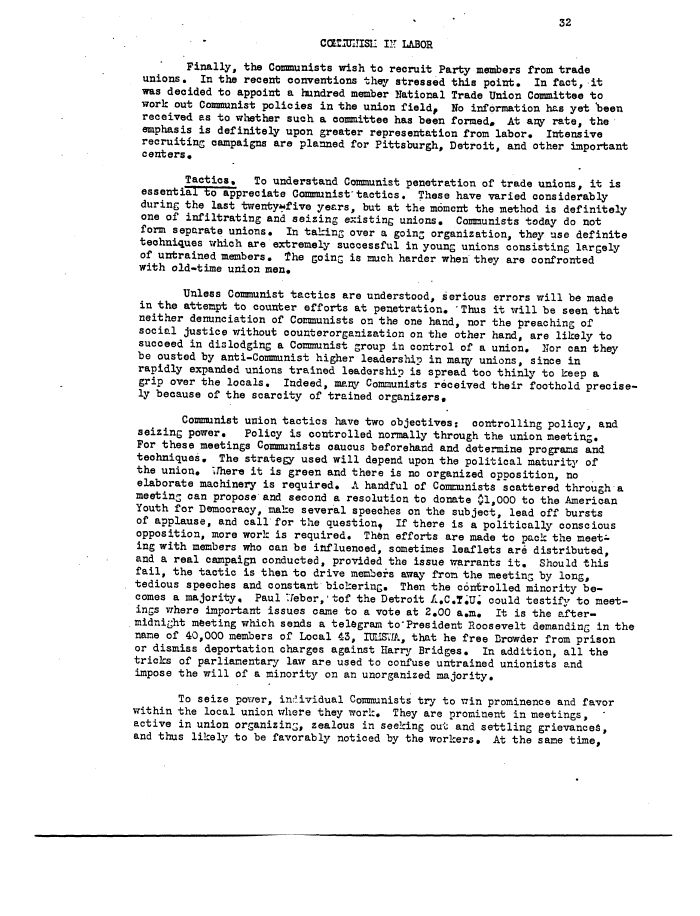 |
||||
 |
||||
| 32 CCKTUITISi: II-T LABOR Finally, the Communists wish to recruit Party members from trade unions. In the recent conventions they stressed this point. In fact, it was decided to appoint a hundred member National Trade Union Committee to work out Communist policies in the union field. No information has yet 'been received as to whether such a committee has been formed. At any rate, the emphasis is definitely upon greater representation from labor. Intensive recruiting campaigns are planned for Pittsburgh, Detroit, and other important centers* Tactics, To understand Communist penetration of trade unions, it is essential to appreciate Communist'tactics. These have varied considerably during the last twenty*five years, but at the moment the method is definitely one of infiltrating and seizing existing unions. Communists today do not form separate unions. In taking over a going organization, they use definite techniques which are extremely successful in young unions consisting largely of untrained members, the going is much harder when they are confronted with old-time union men. Unless Communist tactics are understood, serious errors will be made in the attempt to counter efforts at penetration. ' Thus it will be seen that neither denunciation of Communists on the one hand, nor the preaching of social justice without counterorganization on the other hand, are likely to succeed in dislodging a Communist group in control of a union. Nor can they be ousted by anti-Communist higher leadership in many unions, since in rapidly expanded unions trained leadership is spread too thinly to keep a grip over the locals. Indeed, many Communists received their foothold precise- ly because of the scarcity of trained organizers. Communist union tactics have two objectives: controlling policy, and seizing power. Policy is controlled normally through the union meeting. For these meetings Communists caucus beforehand and determine programs and techniques. The strategy used will depend upon the political maturity of the union* ;nier« it is green and there is no organized opoosition, no elaborate machinery is required. A handful of Communists scattered through a meeting can propose and second a resolution to donate 01,000 to the American Youth for Democracy, make several speeches on the subject, lead off bursts of applause, and call for the question. If there is a politically conscious opposition, more work is required. Then efforts are made to pack the meet- ing with members who can be influenced, sometimes leaflets are distributed, and a real campaign conducted, provided the issue warrants it. Should this fail, the tactic is then to drive members away from the meeting by long, tedious speeches and constant bickering. Then the controlled minority be- comes a majority* Paul '7ebor,'tof the Detroit A.C.T.Ui could testify to meet- ings where important issues came to a vote at 2.00 a.m. It is the after- niidnight meeting which sends a telegram to'President Roosevelt demanding in the name of 40,000 members of Local 43, ITJUSYrA, that he free Browder from prison or dismiss deportation charges against Harry Bridges. In addition, all the tricks of parliamentary law are used to confuse untrained unionists and impose the will of a minority on an unorganized majority. To seize pov/er, individual Communists try to win prominence and favor within the local union where they work. They are prominent in meetings, ' active in union organizing, zealous in seeking out and settling grievances, and thus likely to be favorably noticed by the workers. At the same time, |